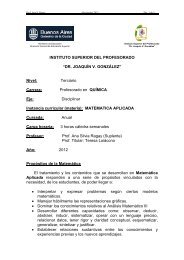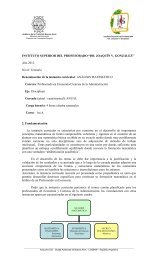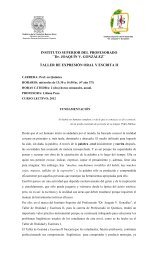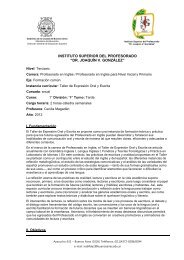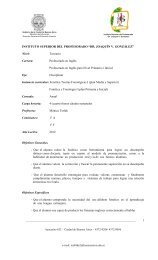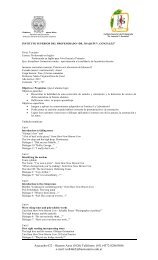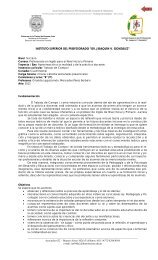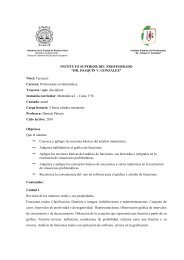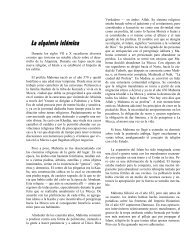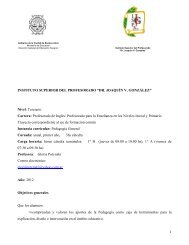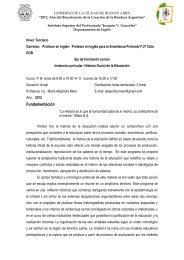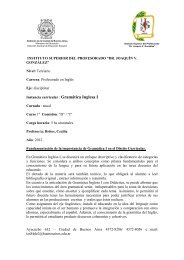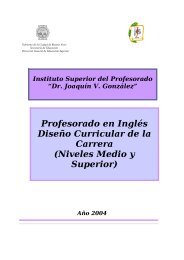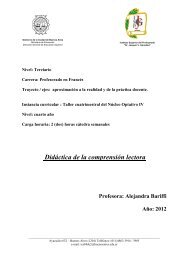Sesiones parale<strong>la</strong>s / Parall<strong>el</strong> sessionsin a long and <strong>la</strong>borious process, which I called “textualization”, as its purposeis to honestly and correctly reproduce the interview in a writt<strong>en</strong> text. In thispaper, we discuss theoretical aspects (especially the ethical consi<strong>de</strong>rations onthe “alteration” of the recor<strong>de</strong>d words) and methodological procedures of thetextualization.La investigación <strong>en</strong> Historia Oral concretiza-se so<strong>la</strong>m<strong>en</strong>te cuándo llega altexto, superando <strong>la</strong> etapa <strong>de</strong> <strong>la</strong> <strong>en</strong>trevista o <strong>la</strong> simple formación <strong>de</strong> archivossonoros. Así, <strong>de</strong>be <strong>de</strong> haber un proceso <strong>de</strong> “transcripción” <strong>de</strong> <strong>la</strong>s <strong>en</strong>trevistasque asegure <strong>la</strong> formación <strong>de</strong> un corpus docum<strong>en</strong>tal a ser estudiado por <strong>el</strong> investigador.Sin embargo, es evi<strong>de</strong>nte que <strong>el</strong> l<strong>en</strong>guaje hab<strong>la</strong>do y escrito ti<strong>en</strong><strong>en</strong>valores distintos. Para que se reconozca <strong>la</strong> voz <strong>de</strong>l narrador <strong>en</strong> <strong>el</strong> texto <strong>de</strong> <strong>la</strong><strong>en</strong>trevista, es necesario que <strong>la</strong> transcripción vaya más allá <strong>de</strong> <strong>la</strong> rigurosa transposición<strong>de</strong> <strong>la</strong>s pa<strong>la</strong>bras grabadas al pap<strong>el</strong>. Esta, <strong>la</strong> l<strong>la</strong>mada “transcripción literal”,es <strong>la</strong> primera etapa <strong>de</strong> un proceso más <strong>la</strong>rgo e trabajoso, que <strong>de</strong>nominé“textualización”, por ser al fin un modo <strong>de</strong> se reproducir honesta y correctam<strong>en</strong>te<strong>la</strong> <strong>en</strong>trevista <strong>en</strong> un texto escrito. En esta comunicación, se discut<strong>en</strong> aspectosteóricos (<strong>en</strong> especial <strong>la</strong>s consi<strong>de</strong>raciones éticas sobre <strong>la</strong> “alteración” <strong>de</strong><strong>la</strong>s pa<strong>la</strong>bras grabadas) y procedimi<strong>en</strong>tos metodológicos <strong>de</strong> <strong>la</strong> textualización.CARDOSO, Jaqu<strong>el</strong>ine H<strong>en</strong>rique y PEREIRA, Lara RodriguesComisión <strong>de</strong> Ética: ¿Reg<strong>la</strong>m<strong>en</strong>tando <strong>la</strong> Historia Oral?Este artículo es parte <strong>de</strong> <strong>la</strong>s investigación <strong>de</strong>l master, <strong>en</strong> Historia <strong>de</strong>l TiempoPres<strong>en</strong>te, se está <strong>de</strong>sarrol<strong>la</strong>ndo <strong>en</strong> <strong>la</strong> Universidad <strong>de</strong>l Estado <strong>de</strong> Santa Catarina,por los investigadores Lara Rodrigues Pereira y Jaqu<strong>el</strong>ine H<strong>en</strong>rique Cardoso.La redacción <strong>de</strong> este texto nació <strong>de</strong> <strong>la</strong> inquietud y <strong>la</strong>s dudas <strong>en</strong> <strong>el</strong> tratocon los objetos <strong>de</strong> estudio <strong>de</strong> los estudiantes, especialm<strong>en</strong>te cuando se <strong>de</strong>cidióhacer uso <strong>de</strong> <strong>la</strong>s fu<strong>en</strong>tes <strong>de</strong> sus <strong>en</strong>sayos, principalm<strong>en</strong>te <strong>oral</strong>. El uso <strong>de</strong><strong>la</strong>s fu<strong>en</strong>tes <strong>oral</strong>es <strong>en</strong> los trabajos <strong>de</strong> investigación <strong>en</strong> <strong>la</strong> <strong>historia</strong>, <strong>en</strong> Brasil, s<strong>el</strong>egitima con <strong>el</strong> adv<strong>en</strong>imi<strong>en</strong>to <strong>de</strong> <strong>la</strong> <strong>de</strong>mocracia y supone una comunión <strong>en</strong>tredos difer<strong>en</strong>tes códigos <strong>de</strong> comunicación: hab<strong>la</strong>r y escribir. En este s<strong>en</strong>tidotrabaja con <strong>el</strong> hab<strong>la</strong> y lo no dicho, que, con frecu<strong>en</strong>cia difíciles <strong>de</strong> interpretar,pero muy r<strong>el</strong>evante cuando se transcribe. De los discursos y los sil<strong>en</strong>cios <strong>de</strong> los<strong>en</strong>cuestados lo hace posible medir los fragm<strong>en</strong>tos <strong>de</strong> un pasado pres<strong>en</strong>te <strong>en</strong>su memoria, y <strong>en</strong> <strong>el</strong> curso <strong>de</strong> <strong>la</strong> investigación, e incluso antes <strong>de</strong> que comi<strong>en</strong>cerealm<strong>en</strong>te, <strong>la</strong>s principales preocupaciones <strong>de</strong> los investigadores <strong>de</strong>be ser iluminadapor <strong>la</strong> ética . Institucionalm<strong>en</strong>te, los investigadores ti<strong>en</strong><strong>en</strong> que recurrira los regu<strong>la</strong>dores <strong>de</strong> <strong>la</strong> investigación con <strong>en</strong>trevistas, con <strong>el</strong> fin <strong>de</strong> preservarlos <strong>en</strong>cuestados, pero los <strong>en</strong>trevistadores. Estos mecanismos <strong>de</strong> protección<strong>de</strong>l investigador y <strong>el</strong> investigado <strong>en</strong> <strong>la</strong>s universida<strong>de</strong>s su<strong>el</strong><strong>en</strong> ser gestionadospor <strong>el</strong> Comité <strong>de</strong> Ética <strong>de</strong> Brasil. Así que <strong>la</strong> pregunta principal que se abordarán<strong>en</strong> este artículo es <strong>el</strong> <strong>de</strong>sarrollo <strong>de</strong> <strong>la</strong> ética <strong>en</strong> <strong>la</strong> investigación a través <strong>de</strong> <strong>la</strong><strong>historia</strong> <strong>oral</strong> y su institucionalización a través <strong>de</strong>l Comité <strong>de</strong> Ética.CASTRO CAMPOS, Fernando y CORNEJO GUZMÁN, YanetEl uso <strong>de</strong>l concepto “verdad” <strong>en</strong> <strong>la</strong> Historia OralA partir <strong>de</strong>l giro lingüístico <strong>en</strong> <strong>la</strong>s ci<strong>en</strong>cias sociales, <strong>la</strong> forma <strong>de</strong> abordar <strong>el</strong> objeto<strong>de</strong> estudio implicó t<strong>en</strong>er <strong>en</strong> cu<strong>en</strong>ta aspectos epistemológicos que pusieron<strong>en</strong> <strong>la</strong> mira <strong>la</strong> cuestión <strong>de</strong> <strong>la</strong> verdad <strong>en</strong> los textos y <strong>la</strong>s narraciones <strong>oral</strong>es altomar postu<strong>la</strong>dos <strong>de</strong> <strong>la</strong> filosofía <strong>de</strong>l l<strong>en</strong>guaje que establec<strong>en</strong> su construcciónsocial y <strong>la</strong> sujeción <strong>de</strong> éste a un contexto <strong>de</strong>terminado: se cuestiona <strong>la</strong> universalidad<strong>de</strong> los conceptos para sujetarlos y a <strong>la</strong> vez compr<strong>en</strong><strong>de</strong>rlos <strong>en</strong> su dim<strong>en</strong>siónsocial y como posibilidad <strong>de</strong> creación y recreación <strong>de</strong> una sociedad.El libro <strong>de</strong> Thomas Kuhn: “La Estructura <strong>de</strong> <strong>la</strong>s Revoluciones Ci<strong>en</strong>tíficas”, esconsi<strong>de</strong>rado como una aportación que evi<strong>de</strong>ncia <strong>la</strong> transitoriedad <strong>de</strong> <strong>la</strong>s teoríasci<strong>en</strong>tíficas y su impacto <strong>en</strong> <strong>la</strong>s <strong>de</strong>más estructuras y perspectivas sociales.En este s<strong>en</strong>tido, <strong>el</strong> uso <strong>de</strong>l concepto verdad como forma <strong>de</strong> legitimación <strong>de</strong>una concepción social <strong>en</strong>tra <strong>en</strong> crisis al ser <strong>de</strong>ve<strong>la</strong>do como un concepto queviol<strong>en</strong>ta otras concepciones sociales y trata <strong>de</strong> imponer una visión unívoca <strong>de</strong><strong>la</strong> realidad. Kuhn estudia <strong>en</strong>tonces cómo los investigadores no son personasaj<strong>en</strong>as al <strong>de</strong>v<strong>en</strong>ir cotidiano <strong>de</strong> <strong>la</strong> sociedad y, <strong>en</strong> esa medida, son actores activos<strong>de</strong> <strong>la</strong> imposición o transformación <strong>de</strong> una realidad.De acuerdo a lo anterior, <strong>en</strong> <strong>el</strong> <strong>de</strong>sarrollo <strong>de</strong>l texto se abordarán los aspectoséticos que implica <strong>el</strong> uso <strong>de</strong>l concepto verdad <strong>en</strong> <strong>la</strong> Historia Oral, <strong>la</strong>s tradicionesepistemológicas a <strong>la</strong>s que se suscribe y los problemas que suscita actualm<strong>en</strong>te<strong>el</strong> uso <strong>de</strong> éste. Ya que consi<strong>de</strong>ramos que <strong>el</strong> uso <strong>de</strong>l concepto verdad porparte <strong>de</strong> los narradores se convierte g<strong>en</strong>eralm<strong>en</strong>te <strong>en</strong> <strong>la</strong> c<strong>la</strong>usura <strong>de</strong>l diálogocon posturas disi<strong>de</strong>ntes e implica seguir viol<strong>en</strong>tando perspectivas <strong>de</strong>bido aque <strong>el</strong> sólo hecho <strong>de</strong> utilizar <strong>el</strong> término verdad, conlleva a que una versión distintaa ésta se consi<strong>de</strong>re m<strong>en</strong>tira. En consecu<strong>en</strong>cia, <strong>el</strong> pap<strong>el</strong> <strong>de</strong>l investigadorno es <strong>de</strong>cir cuál <strong>de</strong> <strong>la</strong>s narraciones es verdad o falsedad, si<strong>en</strong>do sí <strong>el</strong> cuestionar<strong>el</strong> s<strong>en</strong>tido <strong>de</strong> los campos sociales que se estudian: qué se legítima o se <strong>de</strong>slegitima.After the Linguistic Turn, the approach to the objects of study involved consi<strong>de</strong>ringepistemological aspects that set their sights on the matter of truth intexts and <strong>oral</strong> narratives assuming postu<strong>la</strong>tes of the philosophy of <strong>la</strong>nguagethat establish their social construction and fast<strong>en</strong>ing them to a specific context.Questioning the universality of concepts, to hold them and compreh<strong>en</strong>dtheir social dim<strong>en</strong>sion as a possibility of creation and recreation of a society.Thomas Kuhn’s The Structure of Sci<strong>en</strong>tific Revolutions is consi<strong>de</strong>red a contributionthat <strong>de</strong>monstrates the transi<strong>en</strong>ce of sci<strong>en</strong>tific theories and their impacton other structures and social perspectives.In this s<strong>en</strong>se, the use of the concept of true as a legitimizing form of a socialconception that impose a single version of reality faces a crisis wh<strong>en</strong> vio<strong>la</strong>tesother social concepts. Kuhn th<strong>en</strong> examines how researchers are not outsi<strong>de</strong>rsof the daily life of society but they p<strong>la</strong>y an active role in the imposition andtransformation of reality.According to the above, the pres<strong>en</strong>t paper will address the ethical issues associatedto the use of the concept of truth in <strong>oral</strong> history, the epistemologicaltraditions to whom it subscribes and the issues raised in its use. Since the narratorsuse of the concept of truth is consi<strong>de</strong>red to close dialogue with dissi<strong>de</strong>ntviews and involves the vio<strong>la</strong>tion of differ<strong>en</strong>t perspectives since the merefact of using the word true leads to consi<strong>de</strong>r any differ<strong>en</strong>t version of the facts asfalse. Consequ<strong>en</strong>tly, the researcher’s role is not to state which of the theoriesis true or not, but to question the s<strong>en</strong>se of the social fi<strong>el</strong>ds un<strong>de</strong>r study: what islegitimate and what is discredited.MORAVKOVA , Na<strong>de</strong>zdaEthical aspects of using <strong>oral</strong> history methods in teachinghistoryEn este trabajo se ocupa <strong>de</strong> los aspectos éticos <strong>de</strong> los métodos <strong>de</strong> <strong>historia</strong> <strong>oral</strong><strong>en</strong> <strong>la</strong> <strong>en</strong>señanza <strong>de</strong> <strong>la</strong> escue<strong>la</strong>. El autor <strong>en</strong> base a su experi<strong>en</strong>cia y conocimi<strong>en</strong>tos<strong>de</strong>l equipo <strong>de</strong> colegas <strong>de</strong>l C<strong>en</strong>tro <strong>de</strong> Historia Oral <strong>de</strong>l Departam<strong>en</strong>to <strong>de</strong> Historia,Universidad <strong>de</strong> los puntos <strong>de</strong>l oeste a cabo algunas <strong>de</strong> <strong>la</strong>s dificulta<strong>de</strong>s <strong>de</strong>los métodos <strong>de</strong> aplicación <strong>de</strong> <strong>en</strong>señanza. La experi<strong>en</strong>cia se vincu<strong>la</strong> principalm<strong>en</strong>tecon <strong>la</strong> <strong>en</strong>señanza <strong>de</strong> <strong>la</strong> <strong>historia</strong> mo<strong>de</strong>rna, <strong>la</strong> <strong>historia</strong> <strong>de</strong>l socialismo <strong>en</strong><strong>la</strong> antigua Checoslovaquia y <strong>la</strong> <strong>historia</strong> <strong>de</strong> <strong>la</strong> Segunda Guerra Mundial. El autortambién da algunos consejos sobre cómo controversias éticas <strong>en</strong> <strong>el</strong> uso <strong>de</strong> <strong>la</strong><strong>historia</strong> <strong>oral</strong> <strong>en</strong> <strong>el</strong> rostro <strong>de</strong> <strong>la</strong>s escue<strong>la</strong>s.——————————————————————————————————————————————Subtema / Subteme 3Salud e <strong>historia</strong> <strong>oral</strong> / Health Oral HistorySa<strong>la</strong> D - Mesa / Session 12Coordinan / Chair: C<strong>el</strong>ia Sipes——————————————————————————————————————————————CASTRO HERNANDEZ, Shiduet MarianaCuerpo y salud-<strong>en</strong>fermedad: <strong>historia</strong> <strong>oral</strong> con niños¿Cómo es que los niños construy<strong>en</strong> su noción <strong>de</strong> cuerpo y salud? Es a lo quedaremos respuesta a través <strong>de</strong> <strong>la</strong> <strong>historia</strong> <strong>oral</strong> con niños <strong>de</strong> <strong>en</strong>tre 7 y 16 años <strong>de</strong>edad. <strong>Los</strong> niños van construy<strong>en</strong>do nociones sobre su cuerpo y salud apoyados<strong>en</strong> <strong>la</strong> educación esco<strong>la</strong>r y <strong>la</strong> formación familiar que se les brinda, pero finalm<strong>en</strong>teson los niños los que construy<strong>en</strong> y van incorporando <strong>el</strong>em<strong>en</strong>tos <strong>de</strong> supropia experi<strong>en</strong>cia <strong>en</strong> tanto viv<strong>en</strong> y si<strong>en</strong>t<strong>en</strong> a partir <strong>de</strong> su cuerpo. Conformandotoda una explicación y repres<strong>en</strong>tación <strong>de</strong> lo que es su cuerpo <strong>en</strong> re<strong>la</strong>ción alos procesos <strong>de</strong> salud-<strong>en</strong>fermedad que han vivido. Sus testimonios dan cu<strong>en</strong>ta<strong>de</strong> <strong>la</strong> concreción <strong>de</strong> una memoria social <strong>en</strong> torno al cuerpo, <strong>la</strong> salud y <strong>la</strong> <strong>en</strong>fermedady <strong>de</strong> los tratami<strong>en</strong>tos alternativos <strong>en</strong> salud.FARINHA, Alessandra Buriol y LEOTI, AliceEl ocio que cura: Cu<strong>en</strong>tos <strong>de</strong> antiguos veranos <strong>en</strong> <strong>la</strong>costa sur <strong>de</strong> BrasilLa ciudad <strong>de</strong> Rio Gran<strong>de</strong>, <strong>en</strong> Rio Gran<strong>de</strong> do Sul es <strong>la</strong> primera refer<strong>en</strong>cia lusobrasileña<strong>de</strong>l sur <strong>de</strong> Brasil. La Praia do Cassino, <strong>en</strong> Rio Gran<strong>de</strong>, fue fundada<strong>en</strong> 1890, es <strong>la</strong> primera temporada <strong>de</strong> baño prevista <strong>en</strong> Brasil, un important<strong>el</strong>ugar <strong>de</strong> <strong>la</strong> memoria social y <strong>de</strong> ocio <strong>en</strong> <strong>el</strong> sur. En este contexto <strong>de</strong> <strong>de</strong>sarrollo<strong>de</strong>l <strong>siglo</strong> XIX, <strong>el</strong> Cassino fue consi<strong>de</strong>rado como un lugar para <strong>el</strong> <strong>de</strong>scanso y <strong>el</strong>ocio <strong>de</strong> <strong>la</strong>s familias ricas, que se conc<strong>en</strong>traron <strong>en</strong> <strong>el</strong> primer hot<strong>el</strong> <strong>en</strong> <strong>el</strong> complejo<strong>de</strong>nominado Hot<strong>el</strong> Casino. Las visitas al hot<strong>el</strong> t<strong>en</strong>ían fines <strong>de</strong> ocio, ve<strong>la</strong>das,fiestas, ser<strong>en</strong>atas y <strong>la</strong> ruleta, sino también por razones re<strong>la</strong>cionadas con <strong>la</strong> curación,para estar cerca <strong>de</strong> <strong>la</strong>s aguas he<strong>la</strong>das. El acto <strong>de</strong> bañarse, respirando<strong>el</strong> aire fresco <strong>de</strong> <strong>la</strong> costa, fueron consi<strong>de</strong>radas acciones que <strong>de</strong> cura y evitar <strong>el</strong>contagio <strong>de</strong> <strong>en</strong>fermeda<strong>de</strong>s. Este trabajo se resume <strong>en</strong> un int<strong>en</strong>to <strong>de</strong> reconocer54
Sesiones parale<strong>la</strong>s / Parall<strong>el</strong> sessions<strong>la</strong> importancia histórica <strong>de</strong> este lugar por intermedio <strong>de</strong>l <strong>de</strong>scubrimi<strong>en</strong>to <strong>de</strong><strong>la</strong>s maneras <strong>de</strong> turistas y bañistas <strong>de</strong> principios <strong>de</strong>l <strong>siglo</strong> XX. El estudio pue<strong>de</strong>ser consi<strong>de</strong>rado una forma <strong>de</strong> co<strong>la</strong>borar con <strong>la</strong> preservación <strong>de</strong>l lugar a través<strong>de</strong>l conocimi<strong>en</strong>to. La justificación vi<strong>en</strong>e dada por <strong>la</strong> escasez <strong>de</strong> refer<strong>en</strong>ciashistóricas sobre <strong>el</strong> Cassino. <strong>Los</strong> datos se realizaron búsquedas <strong>de</strong> los re<strong>la</strong>tos<strong>de</strong> activida<strong>de</strong>s <strong>de</strong> los visitantes, especialm<strong>en</strong>te a activida<strong>de</strong>s <strong>de</strong> ocio y bañosterapéuticos <strong>en</strong> <strong>la</strong> Praia do Cassino, <strong>en</strong> <strong>el</strong> <strong>siglo</strong> XX. La hidroterapia se conocebi<strong>en</strong> <strong>de</strong>s<strong>de</strong> <strong>el</strong> principio <strong>de</strong>l <strong>siglo</strong>, muchas naciones consi<strong>de</strong>ran baños terapéuticos<strong>en</strong> agua fría y sa<strong>la</strong>da. También se realizó investigación <strong>en</strong> <strong>la</strong>s colecciones<strong>de</strong> docum<strong>en</strong>tos antiguos y fotografías <strong>de</strong> <strong>la</strong> ciudad <strong>de</strong> Rio Gran<strong>de</strong>. Se pue<strong>de</strong>concluir que <strong>el</strong> conocimi<strong>en</strong>to histórico <strong>de</strong> los lugares <strong>de</strong> <strong>la</strong> memoria es es<strong>en</strong>cialpara promover formas <strong>de</strong> turismo cultural <strong>de</strong> manera sost<strong>en</strong>ible como un método<strong>de</strong> preservar <strong>el</strong> patrimonio y <strong>la</strong> <strong>historia</strong> <strong>oral</strong> pue<strong>de</strong> ser un método eficaz<strong>de</strong> investigación para buscar <strong>la</strong>s her<strong>en</strong>cias culturales.The city of Rio Gran<strong>de</strong> in Rio Gran<strong>de</strong> do Sul is the first refer<strong>en</strong>ce Luso-Brazilianurban <strong>la</strong>nd in southern Brazil. Economic activities are <strong>de</strong>v<strong>el</strong>oped around 1850,causing economic and social progress and cultural <strong>de</strong>v<strong>el</strong>opm<strong>en</strong>t. The Casinobeach, in Rio Gran<strong>de</strong>, was foun<strong>de</strong>d in 1890, is the first p<strong>la</strong>nned seasi<strong>de</strong> resortof the country, an important refer<strong>en</strong>ce memory and p<strong>la</strong>ce of leisure in thesouthern region. In this <strong>de</strong>v<strong>el</strong>opm<strong>en</strong>t context, the Casino was consi<strong>de</strong>red asa p<strong>la</strong>ce of sociability and leisure of wealthy families, who were conc<strong>en</strong>tratedin the first hot<strong>el</strong> in the seasi<strong>de</strong> resort called the Casino Hot<strong>el</strong>. The visits to thehot<strong>el</strong> were motivated by pleasure, had soirees, parties, ser<strong>en</strong>a<strong>de</strong>s and roulette,but also for the sake of healing, for being close to the icy waters and bathein them, breathe the fresh air of the coast, were consi<strong>de</strong>red actions that curedand prev<strong>en</strong>ted diseases. This work is summarized in an attempt to recognizethe historical importance of this discovery by local customs and healingcommon leisure vacationers and bathers of the early tw<strong>en</strong>tieth c<strong>en</strong>tury. Thestudy can be consi<strong>de</strong>red a way to col<strong>la</strong>borate with their preservation throughknowledge. Justified by the scarcity of historical refer<strong>en</strong>ces on the site. Thedata were searched from the narratives of leisure activities and especially onleisure activities and therapeutic baths that occurred at the Casino Beach inthe early tw<strong>en</strong>tieth c<strong>en</strong>tury, hydrotherapy at the time, a time wh<strong>en</strong> many nationsconsi<strong>de</strong>red curative baths cold and salty waters. Was also conducted researchon collections of docum<strong>en</strong>ts and photographs of the city of Rio Gran<strong>de</strong>.It can be conclu<strong>de</strong>d that the historical knowledge of the p<strong>la</strong>ces of memory isess<strong>en</strong>tial to promote forms of cultural tourism in a sustainable way as a methodof preservation of heritage and that <strong>oral</strong> history can be an effective methodof research to look at the awar<strong>en</strong>ess of cultural heritage.MCDOUGALL, FionaLiving Betwe<strong>en</strong> Sound and Sil<strong>en</strong>ceLiving betwe<strong>en</strong> Sound and Sil<strong>en</strong>ce: the Story of a Docum<strong>en</strong>tary <strong>de</strong>scribes theexperi<strong>en</strong>ce of creating a short film about how the Deaf and Hearing culturesintersect in two families. As one of “the other” cultures that exist in our owncommunities – cultures we rar<strong>el</strong>y notice – the traditions and practices of theDeaf culture are worthy of consi<strong>de</strong>ration. As conveyed through the makingof a docum<strong>en</strong>tary, this paper also addresses the nature of vi<strong>de</strong>o production,the specific chall<strong>en</strong>ges in obtaining stories from members of the Deaf culture,and the technical production compon<strong>en</strong>ts necessary for interviewing Deafpeople.The 15-minute docum<strong>en</strong>tary, Living betwe<strong>en</strong> Sound and Sil<strong>en</strong>ce, takes theviewer to where the Deaf and Hearing cultures meet, where families embodythe conflicts and resolutions of two oft<strong>en</strong> opposing life philosophies. Thestory unwinds through the “voices” of two young girls: one a child of <strong>de</strong>afadults (CODA), the other a <strong>de</strong>af child of hearing par<strong>en</strong>ts. These childr<strong>en</strong> growup betwe<strong>en</strong> two cultures, the Hearing and the Deaf, forever ba<strong>la</strong>ncing theworlds of sound and communicating through sign <strong>la</strong>nguage (which for manyis “sil<strong>en</strong>ce”). Their stories convey what it is like to be a part of the other andwhat happ<strong>en</strong>s wh<strong>en</strong> they sometimes fe<strong>el</strong> they don’t fit into either the Hearingor Deaf cultures. As the docum<strong>en</strong>tary reveals the lives of these two familiesand interre<strong>la</strong>tionships, it serves as a window into both cultures. Oft<strong>en</strong> on thefringe of society, the other known as Deaf lives outsi<strong>de</strong> the consciousness ofmainstream culture.Living betwe<strong>en</strong> Sound and Sil<strong>en</strong>ce: the Story behind the Docum<strong>en</strong>tary also exploressome of mainstream society’s myths and b<strong>el</strong>iefs about <strong>de</strong>afness, andit illustrates the drama of b<strong>el</strong>onging, learning differ<strong>en</strong>t skill sets, and being“differ<strong>en</strong>t,” or as some say, disabled. Like the docum<strong>en</strong>tary film, this paperi<strong>de</strong>ntifies the gaps and <strong>en</strong>courages a <strong>de</strong>eper un<strong>de</strong>rstanding of two segm<strong>en</strong>tsof “the other”, the aim being to foster mutual awar<strong>en</strong>ess, acceptance and un<strong>de</strong>rstanding– and to build a bridge betwe<strong>en</strong> the Deaf and Hearing worlds.Martínez Omaña, María ConcepciónUna nueva vida: experi<strong>en</strong>cias y apr<strong>en</strong>dizajes <strong>en</strong> <strong>el</strong>mundo <strong>de</strong> <strong>la</strong> discapacidad <strong>en</strong> MéxicoIn rec<strong>en</strong>t <strong>de</strong>ca<strong>de</strong>s the political and social fights by the <strong>de</strong>f<strong>en</strong>se of the rightsof sectors of the popu<strong>la</strong>tion in conditions of incapacity have acquired greatervisibility. In the aca<strong>de</strong>my diverse conceptions and perspective for studyof the incapacity and disabled, betwe<strong>en</strong> which they emphasize those consi<strong>de</strong>rsthat it as a cultural construction reason why <strong>de</strong>bates the meaning andthe practices to be re<strong>la</strong>ted to the incapacity and the disabled one, as w<strong>el</strong>l asthe mo<strong>de</strong>ls of interv<strong>en</strong>tion, the policies, the programs and the actions of thepublic institutions or private organisms exist that offer services of rehabilitation,un<strong>de</strong>r the point of view of the health and with biological a medica<strong>la</strong>pproach/. In this frame, I consi<strong>de</strong>r that the un<strong>de</strong>rstanding of the world ofthe incapacity and the disabled ones can become rich by means of the studyof the memory of the social actors who live in conditions of incapacity and ofthe recovery of its memories with base in its testimonies in which they narratehis experi<strong>en</strong>ces in the universe of the incapacity. Oral history has p<strong>en</strong>etratedrec<strong>en</strong>tly in the <strong>la</strong>nd of the incapacity and although still he is pr<strong>el</strong>iminaryits approach has <strong>de</strong>monstrated the <strong>en</strong>ormous pot<strong>en</strong>tial and the wealth thatlocks up for <strong>en</strong>riches our perspective of the sociocultural processes whichthey mold the re<strong>la</strong>tions betwe<strong>en</strong> the world of normality and the world of theincapacity and insofar as att<strong>en</strong>tion in the disabled ones has be<strong>en</strong> put is visiblethe necessity to give the word them to inclu<strong>de</strong>/un<strong>de</strong>rstand and to vindicateits civil and political rights. Therefore, by means of the registry of <strong>oral</strong>stories one looks for to analyze the i<strong>de</strong>as, the perceptions, the fe<strong>el</strong>ings, theb<strong>el</strong>iefs, the actions, the conducts, the behaviors, that is to say, the experi<strong>en</strong>cesthat have had the disabled ones that suffers the disease of the aphasia.The peculiar thing of these cases is that it is “normal” individuals and thatbecause of a health ev<strong>en</strong>t they live a condition of incapacity at the mom<strong>en</strong>t;each of them evolved in differ<strong>en</strong>t, medical professional fi<strong>el</strong>ds, accountant,stu<strong>de</strong>nt, industralist, <strong>en</strong>gineer, among others. In aim one is sectors of thepopu<strong>la</strong>tion with an acquired incapacity whose course of life and professionaltrajectory changed drastically of course.ROCHA SP; FERNANDEZ FHB y GALLIAN DMCLa Acupuntura <strong>en</strong> <strong>el</strong> Sistema Único <strong>de</strong> Salud <strong>de</strong>l Municipio<strong>de</strong> São Paulo: Historia y MemoriaLa acupuntura ti<strong>en</strong>e como objetivo <strong>el</strong> tratami<strong>en</strong>to y cura <strong>de</strong> <strong>en</strong>fermeda<strong>de</strong>smediante <strong>la</strong> aplicación <strong>de</strong> estímulos a través <strong>de</strong> <strong>la</strong> pi<strong>el</strong> mediante <strong>la</strong> inserción<strong>de</strong> agujas <strong>en</strong> puntos específicos. El pres<strong>en</strong>te estudio pret<strong>en</strong><strong>de</strong> realizar unainvestigación <strong>de</strong> <strong>la</strong>s diversas fases por <strong>la</strong>s que <strong>la</strong> acupuntura transitó hastasu aceptación <strong>en</strong> <strong>la</strong> medicina tradicional occi<strong>de</strong>ntal y su inclusión <strong>en</strong> <strong>el</strong> SistemaÚnico <strong>de</strong> Salud <strong>de</strong> São Paulo, tomando como base <strong>la</strong>s experi<strong>en</strong>cias <strong>de</strong>vida <strong>de</strong> los practicantes <strong>de</strong> esta técnica, los cuales son responsables <strong>de</strong> suintroducción <strong>en</strong> nuestro contexto, y <strong>en</strong> particu<strong>la</strong>r <strong>en</strong> <strong>el</strong> ámbito <strong>de</strong> <strong>la</strong> salud pública.A<strong>de</strong>más, esta investigación busca analizar <strong>la</strong> aceptación <strong>de</strong> <strong>la</strong> acupunturapor parte <strong>de</strong> los paci<strong>en</strong>tes y <strong>de</strong> los profesionales no practicantes <strong>de</strong> <strong>la</strong>acupuntura, <strong>de</strong>s<strong>de</strong> <strong>el</strong> punto <strong>de</strong> vista <strong>de</strong> los profesionales, así como tambiénanalizar <strong>la</strong> postura <strong>de</strong> los difer<strong>en</strong>tes practicantes <strong>de</strong> <strong>la</strong> acupuntura fr<strong>en</strong>te a <strong>la</strong>necesidad <strong>de</strong> una regu<strong>la</strong>ción <strong>de</strong> esta práctica <strong>en</strong> Brasil fr<strong>en</strong>te a su creci<strong>en</strong>teimportancia como una técnica complem<strong>en</strong>taria a <strong>la</strong> medicina occi<strong>de</strong>ntal, segúnlo recom<strong>en</strong>dado por <strong>el</strong> Decreto 971/2006 <strong>de</strong>l Ministerio <strong>de</strong> Salud, comopráctica multiprofesional, no restringida a los médicos. La metodología propuestaes <strong>la</strong> <strong>de</strong> Historia Oral <strong>de</strong> <strong>la</strong> Vida, para un <strong>en</strong>foque metodológico queresulta ser <strong>el</strong> más a<strong>de</strong>cuado <strong>en</strong> función <strong>de</strong> los objetivos <strong>de</strong>l proyecto, no sólo<strong>de</strong>bido a <strong>la</strong> escasez <strong>de</strong> docum<strong>en</strong>tos escritos re<strong>la</strong>cionados con este procesohistórico, sino también para respon<strong>de</strong>r a <strong>la</strong> int<strong>en</strong>ción <strong>de</strong> mejorar <strong>el</strong> acceso a<strong>la</strong> dim<strong>en</strong>sión <strong>de</strong> <strong>la</strong> experi<strong>en</strong>cia humana g<strong>en</strong>erada <strong>en</strong> <strong>la</strong> trayectoria <strong>de</strong> luchasy <strong>de</strong>safíos. La <strong>historia</strong> <strong>oral</strong> nos permite construir una <strong>historia</strong> más humana,que está <strong>de</strong> acuerdo con los objetivos más g<strong>en</strong>erales <strong>de</strong> este proyecto quese incluy<strong>en</strong> <strong>en</strong> <strong>la</strong> línea <strong>de</strong> investigación <strong>de</strong> Humanida<strong>de</strong>s y Humanización <strong>en</strong>Salud.——————————————————————————————————————————————55



